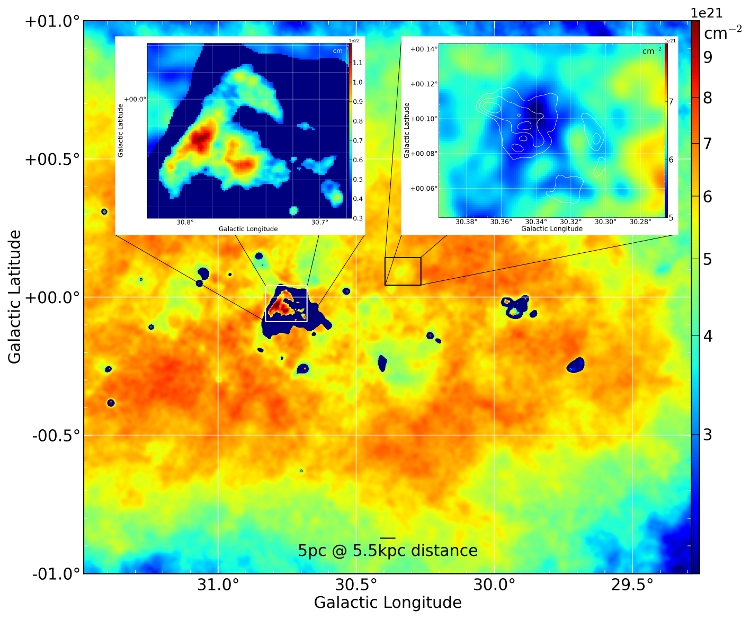| EPoS Contribution |
|
W43 - How much neutral atomic hydrogen is hidden?
Simon Bihr MPIA, Heidelberg, DE | |
|
'CO-dark molecular hydrogen' is a well-known problem in molecular cloud observations. Molecular hydrogen is not directly observable and so CO is used as a tracer instead. Unfortunately, not all of the molecular hydrogen can be traced with CO and an unknown amount of 'CO-dark molecular hydrogen' is unaccounted for. On the other hand, neutral atomic hydrogen is directly observable via the well-known 21cm line. Usually, the 21cm line is assumed to be optically thin. Column densities and masses are calculated with this assumption. However, a significant fraction of HI can be hidden by optical depth effects, such as self absorption (HISA - HI self absorption) or contamination of diffuse continuum emission in the background.
Currently we are conducting the THOR survey (The HI, OH, Recombination Line survey of the Milky Way): a galactic plane survey of the 21cm HI line, four OH lines and 19 recombination lines as well as the continuum from 1-2GHz at a resolution of ~20''. This VLA-Large-Program offers a wealth of data for different fields, from molecular cloud formation and AGB star studies using OH masers to SNR searches in the continuum. My work is focused on the 21cm line and combining this new dataset with previous surveys to reconstruct all spatial scales down to 0.5pc at a typical distance of 5kpc. In my talk, I will give a brief introduction to the THOR survey before going on to explain our methods in measuring the optical depth and spin temperature. Furthermore, I will show results from our study around the active star-forming region W43, which indicate that a significant amount of neutral hydrogen is missing than found in previous studies. In addition to the column density and mass estimates, we employ the kinematic information of the atomic and molecular gas to constrain molecular cloud formation theories. | |
 | |
| Caption: The large map shows an HI column density distribution derived for the 4 square degree region around W43. The upper left inlay presents the HI column density derived from the absorption spectra of the new C-array data (THOR) in combination with the D-array data (VGPS) against the large W43 HII region. The upper right inlay shows a HI self-absorption feature in color with CO emission contours overlaid. | |
| Collaborators: H. Beuther, MPIA, DE S. Glover, ITA, DE Th. Henning, MPIA, DE J. Ott, NRAO, US P. Goldsmith, JPL, US K. Johnston, MPIA, DE F. Motte, CEA/IRFU, FR P. Schilke, U Koelln, DE P. Carlhoff, U Koelln, DE THOR team |
Suggested Session:
Molecular Clouds |

